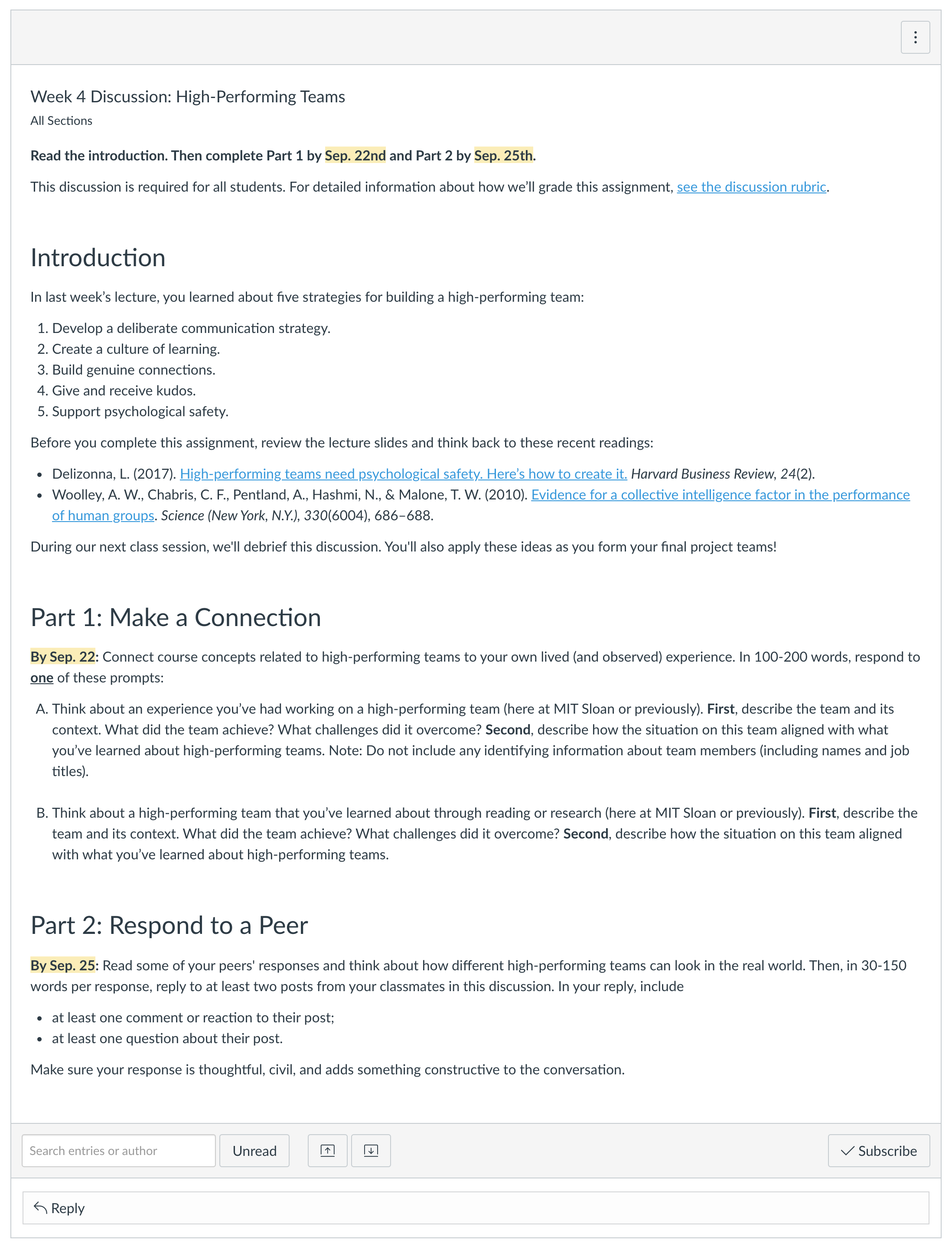Explore these tips and the example discussion prompt to learn how you can design an engaging discussion in Canvas.
An enthusiastic Canvas discussion isn’t just an assignment. It’s a chance to dive into a fascinating topic and connect with your course community. An online discussion can also be a great jumping-off point for in-class activities. Students can use the discussion to reflect on new ideas before class. Instructors can use it to gauge students’ understanding and get inspiration.
A great asynchronous discussion takes some planning. Instructors need to write an effective discussion prompt, provide clear instructions, make a plan for grading and facilitation, and build the discussion board in Canvas.
Explore the tips below to learn how you can design an engaging discussion in Canvas. Then review the example discussion prompt to see these recommendations in action.
4 Tips to Design an Engaging Discussion in Canvas
1. Craft an effective discussion prompt.
Great discussion prompts help students engage with course concepts in new and creative ways. They might also invite a wide variety of unique responses. Here are a few discussion prompt ideas:
- Create a gallery wall. Ask students to share content related to their unique interests or projects. For example, you could ask each student to share a short description of their creative final project.
- Do a role play. Invite students to assume the perspectives of different people from a case study. Alternately, they might act as consultants from different backgrounds advising a case study protagonist. Students can share their roles’ perspectives on the case study challenge and propose next steps.
- Leverage personal experience. Ask students to connect course content to their past experience, background knowledge, or their networks. For example, you might ask students in a leadership course to interview someone they know whose leadership inspires them. They could share a summary and quotes from the interview on the discussion board.
- Bring in the outside world. Encourage students to think about how course concepts relate to current events. For example, in a supply chains course, you might ask students to find a news article related to supply chain disruptions and analyze the situation using concepts from core readings.
- Hold a debate. Ask students to take a position on a controversial issue that’s related to course content. For example, students in a strategic human resources management course might debate about location-based pay differences for remote workers. The discussion board can also help students prepare for a live debate that will take place during the next class meeting.
- Set the scene with multimedia. Use multimedia like pictures, audio, or video to enrich your discussion prompt. For example, you might add a video to your Canvas discussion prompt to showcase a leadership challenge (“That was the day when everything went wrong!”). Then you can ask students to draw on course concepts and their own past experience to analyze the situation.
Tip: Test your prompt with your teaching team before sharing it with your class. For example, you can share the prompt with your TA, ask them to write a response, and invite their feedback on the activity. Then revise your prompt as needed.
2. Provide clear instructions.
Include detailed information about the discussion requirements. Think about answering these questions:
- Is the discussion board required? In a busy world, students are much more likely to respond if it is required.
- Who should participate? Should every student contribute to the discussion? Or should one group of students take part this week and a different group next week?
- How does this discussion fit into the course? It’s important to clarify the activity’s relevance to the course and to students’ learning (Lee, Krieger, and Zolkover 2021). Describe how the topic relates to recent course content and outline any required or suggested pre-work. You might also explain how students will benefit from participating in the discussion. What skills and knowledge will this activity help them develop?
- What should students include in their posts? Provide step-by-step instructions for how to respond to the discussion and (if applicable) other students’ posts. Consider dividing these instructions into multiple sections and including clear bullet points.
- What should students include in their responses to peers’ posts? Let students know about any requirements for their responses to one another’s posts. For example, you might ask students to use a format like 3CQ. That means each response should include one compliment, one comment, one connection (for example, to their own experience), and one question. Structured frameworks like 3CQ can help students start a conversation instead of just saying “I agree” or “I like your idea” (Bonnie Budd, quoted in Lieberman 2019).
- How much should students write? Provide an approximate word count or number of paragraphs for students’ discussion posts and (if applicable) their responses to peers’ posts.
3. Make a plan for grading and facilitation.
Determine how you’ll grade and interact with students on the discussion board. Then make sure your teaching team and your students are clear on the plan.
- Make a facilitation plan. Will you or a teaching assistant respond to every post? Will you only add an occasional comment to the discussion board? Will you share a summary of the online discussion during the next live class? Whatever you do, make sure students know that they’re making valuable contributions to their learning community.
- Decide how you’ll grade discussion posts. You can share your grading guidelines in the prompt or add a rubric to your Canvas discussion. A rubric helps students understand your priorities and monitor their progress. It can also help your teaching team streamline discussion board grading in SpeedGrader.
Tip: If you include a rubric, consider sharing this resource with students: How do I view the rubric for my graded discussion?
4. Make the discussion board easy to find.
Students will only post on the discussion board if they can find it! Fortunately, if you followed MIT Sloan’s Gold Standards for your Canvas site, students will know exactly where to look. Your Canvas site will include one module for each class session. After you create your discussion board, you can add the discussion board to the module for that class session. Then students will see the discussion board right alongside their other homework in Canvas.
Example Discussion Prompt
As you plan your activity, consider this example discussion prompt. This prompt draws inspiration from the example shared in Lee, Krieger, and Zolkover’s 2021 Educause presentation “Change the Prompt, Not the Tool: Developing Effective Discussions.” It puts these tips into practice:
- It invites students to connect course concepts to their own experience or background knowledge.
- It indicates when the assignment is due and how many words students should write in their responses.
- It highlights that the assignment is required.
- It provides context by including links to relevant resources and connecting the assignment to other course content.
- It indicates how the teaching team will follow up on the assignment (by grading students’ posts and providing space to debrief the discussion during the next class session).
You can download the example discussion prompt PDF or review the prompt in this screenshot:

What’s the Research?
Universal Design for Learning
These recommendations for how to design an engaging discussion in Canvas align with Universal Design for Learning (UDL) Guidelines. UDL is a framework for designing learning experiences that meet learners’ diverse needs. The UDL framework is based on research in the learning sciences. It’s premised on the idea that learner variability is the norm, not the exception.
Here’s how several UDL considerations relate to our recommendations:
- 8.3 Foster collaboration, interdependence, and collective learning: Create opportunities for learners to practice collaborative learning and collectively generate knowledge. Learn about the research behind Consideration 8.3.
- 8.1 Clarify the meaning and purpose of goals: As part of your learning experience, build in reminders of both the goal of the experience and the value of that goal. Learn about the research behind Consideration 8.1.
- 6.4 Enhance capacity for monitoring progress: Provide regular formative feedback so students can track their progress. Learn about the research behind Consideration 6.4.
Cognitive Load Theory
Cognitive load theory suggests that students have limited “processing power,” or working memory. That means it’s important to design instructional materials so students can devote maximum processing power to learning rather than extraneous tasks (like finding an activity in the learning management system). When you provide clear instructions and make your discussion board easy to find, you minimize extraneous cognitive load and help your students focus on what matters.
References
Lee, L., Krieger, J. M., & Zolkover, A. D. (2021, October 28). Change the prompt, not the tool: Developing effective discussions. Educause. https://events.educause.edu/annual-conference/2021/agenda/change-the-prompt-not-the-tool-developing-effective-discussions
Lieberman, M. (2019, March 27). New approaches to discussion boards aim for dynamic online learning experiences. Inside Higher Ed. https://www.insidehighered.com/digital-learning/article/2019/03/27/new-approaches-discussion-boards-aim-dynamic-online-learning
Sand dollars and starfish: Making the most out of Canvas discussion boards. (2023, February 15). Instructure. https://community.canvaslms.com/t5/InstructureCon-2019/Sand-Dollars-and-Starfish-Making-the-Most-Out-of-Canvas/m-p/384384








